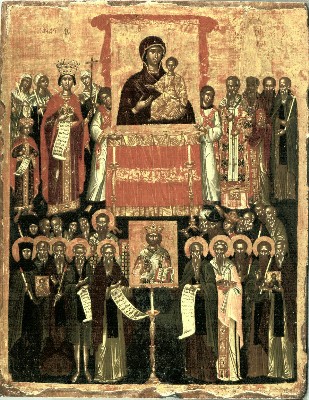|
|
The "Dark Ages" (mid 7th to mid 9th centuries) Iconoclasm |

Icon depicting the final Restoration of Icons of 843 AD. On the upper row, to the left of the Icon with the Virgin and Child is portrayed the empress Theodora with her son Michael.
(Ben. Mus. No 21170. Mid 16th century)
The loss of the lands that for centuries were the granaries of the Roman Empire, and the inevitable economic and social effects, plunged the East into a period of political chaos that lasted until the mid-9th century. The crisis coincided with the iconoclastic controversy that dominated the intellectual and political life of the state until the final victory of the iconophiles in 843.
One of the most significant characteristics of the period, as defined by archaeological evidence, is the gradual domination of a barter economy that replaced money in everyday country life, as well as the disappearance of urban life in the provinces of the Empire. The City, which had formed the main political, economical and cultural formation of the Antique World, began to disintegrate, while church replaced city authorities in several domains of social life.
Iconoclasm was a major theological controversy that lasted from 730 until the final restoration of the Icons in 843. Far from being only a theological dispute among intellectuals, the confrontation between Iconophiles and Iconoclasts, on whether or how icons and saints' relics should be venerated, shattered the whole society, causing strong emotions in the followers of both doctrines. Iconoclasm can be perceived as a multifaceted political and ideological movement, expressing the demands and forces of the period. It was a movement conducted against monastic institutions, and, at the same time, became a struggle of the imperial power to establish its absolute control over ecclesiastical matters. From a different aspect, this controversy can also be seen as a clash between the aniconic beliefs of eastern populations - that did not allow the depiction of god in human form - with the contrary Graeco-Roman tradition. The victory of the Iconophiles allowed the explosive development of Byzantine painting in the centuries to follow.
© 1998 Oxfordshire Museum Service, Setúbal Museums and the Benaki Museum